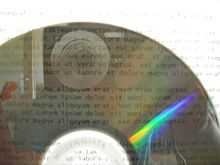M-DISC
 | |
| Media type | write once optical disc |
|---|---|
| Standard | DVD, Blu-ray disc |
| Developed by | Millenniata, Inc. |
| Dimensions | 12 cm |
| Usage | Archival storage |
| Extended from | DVD-R, BD-R |
M-DISC (Millennial Disc) is a write once optical disc technology available in DVD and Blu-ray forms.
Overview



M-DISC's design is intended to provide greater archival media longevity.[1] Millenniata claims that properly stored M-DISC recordings will last 1000 years.[2] While the exact M-DISC are a trade secret,[3] the patents protecting the M-DISC technology asserts that the data layer is a "glassy carbon" and that the material is substantially inert to oxidation and has a melting point between 200°-1000 °C. [4][5]
A stress test was performed by the Department of Defense of the media, proving at the very least that M-Disc DVDs and Blu-rays are more durable than conventional DVDs and Blu-rays. "The discs were subject to the following test conditions in the environmental chamber: 85°C, 85% relative humidity (conditions specified in ECMA-379) and full spectrum light"[6][7]
Conventional DVD-R and BD-R LTH (Low To High) use recording layers of organic dye and separate reflective layers.[8] Standard (HTL) BD-R and BD-R/DL typically use inorganic data layers, but continue using a reflective layer. M-DISC uses a single inorganic recording layer, which is substantially inert to oxygen, but requires a higher powered laser. M-DISC does not require the reflective layer. Thus, both the M-DISC, and inorganic BD-R, physically alter the recording layer, burning a permanent hole in the material. Besides physical damage, failure of the reflective layer, followed closely by degradation of the data layer, are the primary failure modes of all optically recordable disks.
Recorded discs are readable in conventional drives.
LG Electronics, ASUS and Lite-On [9] produce drives which can record M-DISC media. Ritek produces M-DISC Blu-ray disc media, sold under the Imation, Ritek and M-DISC brands.[10][11]
History
M-DISC developer Millenniata, Inc. was co-founded by BYU professors Barry Lunt[12] and Matthew Linford,[13] along with CEO Henry O'Connell and CTO Doug Hansen.[14] The company was incorporated on May 13, 2010 in American Fork, Utah.[15]
References
- ↑ "Final Report for Millenniata DVD Testing August 2009-October 2009", Naval Air Warfare Center Weapons Division. Retrieved 10 November 2009.
- ↑ Front Page
- ↑ mDisc Review
- ↑ "Optical data storage media containing substantially inert low melting temperature data layer US 8389095 B2", Patent US 8389095. Retrieved 25 September 2014.
- ↑ "Long-term digital data storage US 7613869 B2", Patent US 7613869. Retrieved 25 September 2014.
- ↑ "75 page breakdown of the D.O.D.'s findings"
- ↑ "2 page summary of DOD's findings"
- ↑ See CD-R for an overview
- ↑ "Lite-On eBAU108 Product Information"Lite-On Corp. Retrieved 19 February 2014.
- ↑ "Millenniata Archiving Blu-ray M-Disc Available in Spring 2013" StorageNewsletter.com. Retrieved 10 January 2013.
- ↑ "M-Disc's list of devices that can write
- ↑ Barry Lunt Website
- ↑ Matthew Linford Website
- ↑ Douglas Hansen Biography
- ↑ "Springville company introduces new DVD to protect data for a thousand years or more"Daily Herald. Retrieved 17 July 2009.
External links
| Wikimedia Commons has media related to Millennial Disc. |